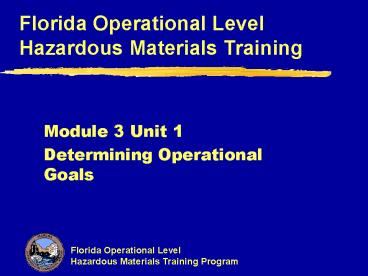Module 3 Unit 1 - PowerPoint PPT Presentation
1 / 37
Title:
Module 3 Unit 1
Description:
Describe potential roles of the operation responder. Identify the ... Minimum PPE is fire fighter protective clothing and PP/SCBA. Decontamination issue of FFPC ... – PowerPoint PPT presentation
Number of Views:69
Avg rating:3.0/5.0
Title: Module 3 Unit 1
1
- Module 3 Unit 1
- Determining Operational Goals
2
Objectives
- Describe potential roles of the operation
responder - Identify the steps for determining objectives
- Perform a hazard/risk assessment
- Identify when withdraw may be indicated
- Identify when and how to obtain assistance
3
Duty to Act
4
Goals
- Awareness Level
- Recognize/Identify
- Isolate
- Protect
- Notify
- Operational Level
- Recognize/Identify
- Isolate
- Protect
- Notify
- Spill Control (Defensive)
- Leak Control (Defensive)
- Fire Control (Defensive)
- Recovery/Terminate
5
Your Role in Management
- Assess actions of Awareness responders
- Improve if necessary
- Assess exposures (vulnerabilities)
- Maintain defensive role
- Obtain assistance
- Technician level response if needed
6
Risk/Benefit Analysis
- What are the risks
- What are your capabilities
- What benefits can be gained
- No - win situations (Losers)
7
The Management Process (GEDAPER)
- Gather information
- Estimate potential course and harm
- Determine strategic goals
- Assess tactical options to meet goals
- Plan and implement your actions
- Evaluate progress
- Review periodically
Goals Next Page
8
Goals for Haz-Mat Response
- Recognize
- Isolate
- Protect
- Notify
- Spill Control
- Leak Control
- Fire Control
- Recovery / Termination
Dont forget the goals
9
Determine Operational Goals
- After we gather information and estimate
potential course and harm (hazard/risk
assessment) we then determine our operational
goals. - Risk/Benefit decision making
10
- Activity 3.1
- Identifying Goals
11
- Module 3 Unit 2
- Command and Safety
12
Objectives
- Identify the need for the use of an Incident
Management System - Identify the responsibility to establish and
enforce control procedures - Identify proper personal protective equipment
- Identify the roles of the Safety Officer and EMS
responders
13
Managing the Scene
- The Incident Command System
- Required implementation (29 CFR 1910.120)
- Complexity requires effective and efficient
management of resources - Benefits to the use of the ICS
- Manages resources, Personal accountability
- Documentation, Effective communications
14
The Incident Command System
- Key terms
- Unity of command
- Span of control
- Functions of Command (five)
- Command, Operations
- Finance, Logistics
- Planning
15
The ICS System Organization
16
Command Post Operations
- Location Considerations
17
Scene Control
18
Control Zones
WIND
Incident
Entry Corridor
Decontamination
Safe Refuge
COLD
HOT
WARM
19
Protective Actions
- Evacuation
- Shelter in place
20
Accomplishing Safety
- Use of PPE
- Minimum PPE is fire fighter protective clothing
and PP/SCBA - Decontamination issue of FFPC
- The Safety Officer
- Requirements
- Authority (Suspend, alter, terminate)
21
The Safety Officer
- Develops a Site Safety Plan
- Initial safety plan
- Site specific safe plan
- Pre-entry briefing
- Other Responsibilities
- Insures accountability, decontamination
- Proper PPE, assesses scene for all hazards
22
Role of EMS During Incidents
- Requirements
- Primary Roles
- Responder Monitoring
- Treatment of Injuries
- Monitoring
- Medical evaluation
- Pre-habilation and Rehabilitation
23
Summary
- The ICS
- The Safety Officer
- Roles of EMS
24
- Module 3 Unit 3
- Personal Protective Equipment
25
Objectives
- Describe the principles of hazards based response
- Identify protective measure considerations for
life saving rescues - Determine appropriate PPE
- Identify basic capabilities and limitations of
various types of PPE
26
Hazard Based Response
- The process of developing personal protective
measures designed to specifically address the
hazards that are present at the scene in order to
achieve an acceptable level of risk
27
Hazard Based Response
- Acceptable risk
- Step 1 Identify hazards
- Step 2 Develop measures to reduce each hazard
28
Identify and Reduce Hazards
- Thermal
- Etiological
- Asphyxiation
- Mechanical
- Chemical
- Psychological
- Radiological
29
Personal Protection
- Minimum level of protection for Operational level
responders
30
Respiratory Protection
- Air purifying respirators (APRs)
- Limitations and use criteria
- 1001 PF for full face
- Supplied air breathing apparatus (SABA)
- Tethered air lines with escape capability
- 10,0001 PF for positive pressure
- Positive Pressure SCBA
- Highest level of protection, 10,0001 PF
31
Dermal Protection
- Support garments (NFPA 1993)
- Specialized thermal
- Splash protective
- Vapor protective
32
Level C Protective Clothing
- Respiratory APR
- Dermal Splash
- Limitations
- Must know contaminant
- Must measure
- Must have 19.5 O2
- Must have proper filter
33
Level B Protective Clothing
- RespiratoryPP/SCBA or SABA
- Dermal Splash
- Minimum for unknown
- Limitations
- Not for IDLH skin
- Excellent respiratory
- Used for incidental splash only
34
Level A Protective Clothing
- Respiratory PP/SCBA
- Dermal Vapor protective
- Limitations
- No thermal protection
- High heat stress hazard
- Good for repeated contact or high vapor
concentrations
35
Summary Table of Levels
36
Summary
- Hazards based response
- Personal protective equipment
37
- Module Activity 3.3
- Hazard Based Response































